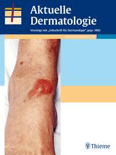
CONTACT DERMATITIS
metrics 2024
Pioneering Knowledge in Dermatology and Immunology
Introduction
CONTACT DERMATITIS, published by WILEY, is a leading international journal focused on the vital field of dermatology, particularly examining the diagnosis, treatment, and management of contact dermatitis and related skin conditions. With origins dating back to 1975 and a planned convergence period extending to 2024, this esteemed journal serves as a crucial resource for researchers, clinicians, and healthcare professionals dedicated to advancing knowledge in dermatological practices. In the latest rankings, it has achieved a commendable Q2 classification in Dermatology and Q3 classification in Immunology and Allergy for 2023, underscoring its significance within these dynamic fields. Moreover, it holds a notable ranking of #29/142 in Medicine & Dermatology and #130/233 in Medicine & Immunology and Allergy according to Scopus metrics, placing it in the top tier of scholarly publications. While the journal operates on a subscription basis, its comprehensive reviews, original articles, and insightful research findings are invaluable for pushing the boundaries of current dermatological and immunological knowledge. By fostering a deeper understanding of the complexities of skin reactions and their implications, CONTACT DERMATITIS plays a vital role in connecting research with clinical practice, making it an essential read for anyone engaged in the field.
Metrics 2024
 0.68
0.68 4.80
4.80 4.60
4.60 109
109Metrics History
Rank 2024
Scopus
IF (Web Of Science)
JCI (Web Of Science)
Quartile History
Similar Journals

SKIN RESEARCH AND TECHNOLOGY
Elevating Knowledge in Skin Research and Clinical Practices.SKIN RESEARCH AND TECHNOLOGY, a distinguished publication by Wiley, stands at the forefront of dermatological science, emphasizing innovative research and technological advances in skin health. With an ISSN of 0909-752X and an E-ISSN of 1600-0846, this journal serves as a vital platform for researchers and professionals to present their findings and engage in discussions surrounding skin biology, clinical practices, and therapeutic technologies. As evidenced by its respectable Q2 ranking in the dermatology category for 2023 and a Q3 status in miscellaneous medicine, the journal attracts a broad readership and contributes significantly to the field. Housed in the United Kingdom with publications spanning from 1995 to 2024, SKIN RESEARCH AND TECHNOLOGY continues to foster innovation and knowledge dissemination in skin-related research. While its Access options are not open, the impact of the journal remains prominent, appealing to academic professionals and students eager to explore emerging trends and advancements in dermatological studies.

Dermatologie
Shaping the Future of Dermatological CareDermatologie, published by SPRINGER HEIDELBERG, is a prominent journal dedicated to the advancing field of dermatology. With its ISSN 2731-7005 and E-ISSN 2731-7013, this journal has established itself as a valuable resource for researchers, professionals, and students alike. Originating in Germany, the journal focuses on disseminating innovative research from 2022 to 2024, contributing significantly to the understanding of skin health and disease management. Despite its current ranking within the Q3 category in dermatology and a Scopus rank of #88/142, it provides critical insights and advances in clinical practice, epidemiology, and therapeutic modalities. With an emphasis on open discourse, it seeks to foster collaboration among healthcare professionals and researchers, thereby enhancing the quality and accessibility of dermatological research. Engage with Dermatologie to stay at the forefront of the latest advancements in skin-related health issues.

World Allergy Organization Journal
Transforming Allergy Insights into Clinical PracticeWorld Allergy Organization Journal is a premier open-access publication dedicated to advancing the understanding and treatment of allergic diseases and related conditions. Published by ELSEVIER, this journal boasts a commendable impact factor and ranks in the second quartile for both Immunology and Allergy, as well as the first quartile in Pulmonary and Respiratory Medicine. Since its inception as an open-access journal in 2008, it has consistently aimed to provide a credible platform for researchers, clinicians, and students to disseminate original research, reviews, and clinical studies. With its emphasis on high-quality scholarship and practical applications, the World Allergy Organization Journal plays a crucial role in bridging theoretical knowledge with clinical practice, making significant contributions to the fields of immunology, allergy, and respiratory medicine. The journal is particularly notable for its accessibility to a global audience, exemplified by its open-access model since 2008, promoting a wider exchange of ideas and innovations across borders.

Dermatitis
Elevating Standards in Skin Health ResearchDermatitis, published by MARY ANN LIEBERT, INC, is a leading journal that focuses on the study of skin inflammation and allergic reactions, making significant contributions to the fields of Dermatology, Immunology, and Allergy. With an ISSN of 1710-3568 and an E-ISSN of 2162-5220, this peer-reviewed journal serves as a critical platform for researchers, healthcare professionals, and students alike, eager to share and explore groundbreaking findings and developments. Recognized for its impact and rigorous scholarly standards, Dermatitis has achieved a Q2 quartile ranking in dermatology and a Q3 ranking in immunology and allergy as of 2023, underscoring its significance in these vital medical sectors. The journal's Scopus ranking places it in the 84th percentile for dermatology and the 50th percentile for immunology and allergy, reflecting its wide acceptance and influence. With a scope spanning from 2004 to 2024, Dermatitis invites original research, reviews, and clinical updates that advance the understanding of skin disorders and therapy innovations, solidifying its role as an essential resource in enhancing skin health worldwide.

AKTUELLE DERMATOLOGIE
Transforming Dermatology with Every PublicationAKTUELLE DERMATOLOGIE is a distinguished journal in the field of Dermatology, published by GEORG THIEME VERLAG KG in Germany. With a commitment to advancing knowledge and practice in dermatological science, the journal has regularly featured research articles, reviews, and case studies since its inception in 1975 and continues to publish contributions through 2024. Despite being categorized in the lower quartile (Q4) of dermatology journals and holding a Scopus rank of #127 out of 142, it plays a pivotal role in disseminating valuable insights that support ongoing education and research in the discipline. The journal provides an essential platform for both seasoned professionals and budding researchers to share their findings, explore emerging trends, and discuss clinical practices, all while serving the needs of an evolving medical landscape. Access to its content may be restricted, but the journal remains a crucial reference for those invested in the future of dermatological research and patient care.

Acta Dermatovenerologica Croatica
Shaping the Future of Skin Health ResearchActa Dermatovenerologica Croatica is a premier journal dedicated to the fields of dermatology and venereology, published by the Croatian Dermatovenereological Society. Established in 1994, this journal has been a vital platform for disseminating research and advancements in the understanding and treatment of skin diseases and sexually transmitted infections. Although it is currently classified in the Q4 quartile for dermatology, infectious diseases, and miscellaneous medicine, it provides a unique opportunity for emerging researchers and seasoned professionals to contribute to a growing body of knowledge. Based in Zagreb, Croatia, the journal emphasizes free access to information that enhances clinical practices and scientific understanding among dermatologists and venereologists worldwide. As the journal approaches its 30th anniversary, it continues to aim for excellence in research quality, fostering collaboration, and innovating in the ever-evolving fields it represents.

VETERINARY DERMATOLOGY
Championing excellence in veterinary dermatology since 1990.Veterinary Dermatology is a prestigious peer-reviewed journal dedicated to advancing the field of veterinary dermatology, published by Wiley. With a longstanding commitment to disseminating high-quality research since its inception in 1990, this journal has garnered significant recognition, achieving a commendable Q1 ranking in the Veterinary (miscellaneous) category for 2023 and ranking #42 out of 194 in the General Veterinary category on Scopus, placing it within the 78th percentile. Although it operates primarily on a subscription basis, the journal offers vital insights into the latest developments, clinical practices, and case studies in veterinary skin disorders. By serving as a crucial platform for researchers, veterinary professionals, and students, Veterinary Dermatology empowers its audience with the knowledge necessary to enhance animal healthcare and well-being across diverse environments. With its focus on cutting-edge research and its contribution to the global veterinary community, this journal remains an indispensable resource for those dedicated to the field.

Dermatology Reports
Empowering dermatology with cutting-edge research.Dermatology Reports is a reputable open-access journal dedicated to advancing the field of dermatology through innovative research and clinical studies. Published by PAGEPRESS PUBL, this journal has been providing unrestricted access to valuable scientific content since 2009, promoting the dissemination of cutting-edge knowledge among researchers, professionals, and students alike. With an ISSN of 2036-7392 and an E-ISSN of 2036-7406, Dermatology Reports is indexed in Scopus, currently holding a rank of 93/142 in the Medicine - Dermatology category, placing it in the 34th percentile. The journal, based in Italy at MEDITGROUP, VIA G BELLI, 4, PAVIA 27100, aims to foster a multidisciplinary approach to dermatological research and practice, with a vision to converge various aspects of the field from 2010 to 2024 and beyond. With its Q3 quartile ranking in 2023, Dermatology Reports stands as a critical platform for highlighting novel findings and therapeutic strategies that shape the future of dermatological science.

JOURNAL DER DEUTSCHEN DERMATOLOGISCHEN GESELLSCHAFT
Elevating the standard of dermatological research and practice.JOURNAL DER DEUTSCHEN DERMATOLOGISCHEN GESELLSCHAFT, published by Wiley, is a prominent periodical in the field of dermatology, recognized by its Q2 quartile ranking in the 2023 dermatology category. With a dedicated focus on advancing knowledge in dermatological science, the journal publishes rigorous peer-reviewed research that encompasses a range of topics including clinical studies, research methodologies, and innovative treatment practices in dermatology. Its impact is reflected in its Scopus ranking, where it stands at #48 out of 142 in the medicine dermatology category, placing it in the top 66th percentile. Although not an Open Access journal, it serves as a critical resource for researchers, clinicians, and students alike, facilitating the dissemination of high-quality research findings and fostering a deeper understanding of dermatological conditions and treatments. With years of convergence from 2003 to 2024, this journal remains a vital platform for scholarly dialogue and discovery in dermatology.

Journal of Cutaneous Immunology and Allergy
Uncovering the complexities of skin health and allergy science.The Journal of Cutaneous Immunology and Allergy, published by FRONTIERS MEDIA SA in Switzerland, is an esteemed Open Access platform dedicated to advancing research in the intersecting fields of dermatology, immunology, and allergy. Since its inception in 2018, this journal has provided a vital resource for the dissemination of innovative research findings and critical reviews, enhancing our understanding of cutaneous conditions related to immune responses. Although currently classified in the Q4 quartile in both Dermatology and Immunology & Allergy categories as of 2023, the journal continues to strive for recognition within the scientific community, encouraging collaboration and knowledge sharing among researchers, clinicians, and experts. The journal boasts an E-ISSN of 2574-4593 and is committed to making high-quality research freely accessible to all, thus fostering greater insights into the complexities of skin-related immune disorders. Join us in this journey to explore the forefront of cutaneous research and contribute to the evolving dialogue in this dynamic field.